
The Dayak or Dyak or Dayuh are one of the native groups of Borneo. It is a loose term for over 200 riverine and hill-dwelling ethnic groups, located principally in the central and southern interior of Borneo, each with its own dialect, customs, laws, territory, and culture, although common distinguishing traits are readily identifiable. Dayak languages are categorised as part of the Austronesian languages. The Dayak were animist in belief; however, since the 19th century there has been mass conversion to Christianity as well as Islam due to the spreading of Abrahamic religions.
The indigenous peoples of Brunei are Bruneian people who belong to the ethnic groups considered indigenous to the country. It is more commonly attributed to indigenous people of the Malay race belonging to the seven ethnic groups, namely: Brunei, Tutong, Belait, Dusun, Murut, Kedayan and Bisaya. The local term rakyat jati refers to citizens of indigenous descent, in particular the aforementioned seven ethnic groups. The term bumiputera has also been sometimes used to refer to the indigenous peoples.

Being an indigenous tribe in Borneo, the Kayan people are similar to their neighbours, the Kenyah tribe, with which they are grouped together with the Bahau people under the Apo Kayan people group. The Kayan people are categorised as a part of the Dayak people. They are distinct from, and not to be confused with, the Kayan people of Myanmar.

The Rajang River is a river in Sarawak, northwest Borneo, Malaysia. The river originates in the Iran Mountains, flows through Kapit, and then towards the South China Sea. At approximately 565 km long (351 mi), the river is the seventh-longest in Borneo and the longest in Malaysia.
Ulu Baram is a remote area of Sarawak in Malaysia. It is an encased alluvial plain, created in part by the Baram River.

Punan Bah or Punan is an ethnic group found in Sarawak, Malaysia and in Kalimantan, Indonesia. The Punan Bah people are distinct and unrelated to the semi-nomadic Penan people. Their name stems from two rivers along the banks of which they have been living since time immemorial. They do have other names: Mikuang Bungulan or Mikuang and Aveang Buan. But those terms are only used ritually these days.

The White Rajahs were a dynastic monarchy of the British Brooke family, who founded and ruled the Raj of Sarawak, located on the north west coast of the island of Borneo, from 1841 to 1946. The first ruler was Briton James Brooke. As a reward for helping the Sultanate of Brunei fight piracy and insurgency among the indigenous peoples, he was granted the province of Kuching, which was known as Sarawak Asal in 1841 and received independent kingdom status.
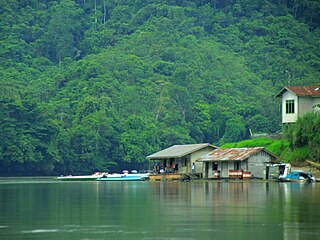
Kayan Mentarang National Park is a densely forested national park located in the Indonesian province of North Kalimantan, on the island of Borneo. The national park is named after a great dispersed Mentarang mountain trails plateau of Apau Kayan which covers the entire park from Datadian area in south region to Apau Ping area in mid region until Long Bawan in north region.

Orang Ulu is an ethnic designation politically coined to group together roughly 27 very small but ethnically diverse tribal groups in northeastern Sarawak, Malaysia with populations ranging from less than 300 persons to over 25,000 persons. Orang Ulu is not a legal term, and no such racial group exists or is listed in the Malaysian Constitution. The term was popularised by the Orang Ulu National Association (OUNA), which was formed in 1969.
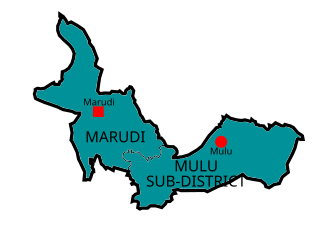
Marudi is a town in the Malaysian state of Sarawak, and is a part of the division of Miri. It is the seat of Marudi District, and is located on the banks of Baram River, about 100 kilometres (62 mi) upstream from the river mouth. Marudi was the administrative centre of the northern region of Sarawak before Miri was established. Marudi is considered as the cultural heart of the Orang Ulu, the highland tribes of Sarawak. It is also a transit gateway to Gunung Mulu National Park, a UNESCO World Heritage Site.
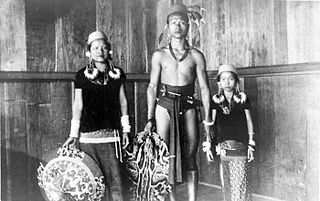
The Kenyah people are an indigenous, Austronesian-speaking people of Borneo, living in interior North and East Kalimantan, Indonesia and Sarawak, Malaysia.
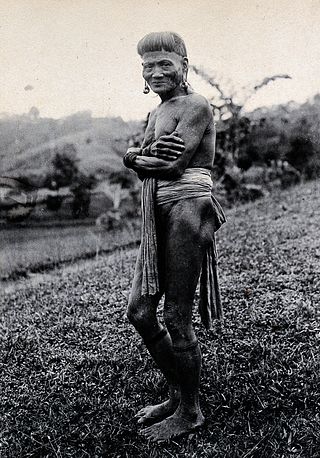
The Ukit people are a tribe found in Sarawak, Malaysia. They are a small minority people who until recently were nomads in the rain forests of Borneo. Some were settled at Rumah Ukit on the upper reaches of the Batang Balui or Balui River. Most of the Ukits are found in the Upper Rajom and Tatau rivers, Baleh, Sarawak. The Ukit people were also regarded as a sub-group of the purported Klemantan people.

The Lun Bawang is an ethnic group found in Central Northern Borneo. They are indigenous to the southwest of Sabah, and the northern region of Sarawak, highlands of North Kalimantan, Brunei.
The Kayanic or Kayan–Murik languages are a group of Austronesian languages spoken in Borneo by the Kayan, Morek Baram, Bahau, and related peoples.
The Greater North Borneo languages are a proposed subgroup of the Austronesian language family. The subgroup covers languages that are spoken throughout much of Borneo, as well as parts of Sumatra and Java, and Mainland Southeast Asia. The Greater North Borneo hypothesis was first proposed by Robert Blust (2010) and further elaborated by Alexander Smith. The evidence presented for this proposal are solely lexical.

Tatau District is one of the two districts of Bintulu Division in Sarawak, Malaysia. It has a total area of 4,945.80 square kilometres. The largest town in the district is Tatau.

Sebauh is a district of Bintulu Division, Sarawak, Malaysia. It shares a boundary with Miri, Baram, Kapit Division, Belaga and Tatau. It has a total area of roughly 5,262.90 square kilometres. Sebauh town is a main administrative and economy centre of Sebauh district.
Sarawak's population is very diverse, comprising many races and ethnic groups. Sarawak has more than 40 sub-ethnic groups, each with its own distinct language, culture and lifestyle. This makes Sarawak demography very distinct and unique compared to its Peninsular counterpart. However, it largely mirrors to other territories in Borneo - Sabah, Brunei and Kalimantan.

Bahau people is a sub-ethnic group of the Dayak people who inhabit West Kutai Regency (9.3%), East Kalimantan, Indonesia.
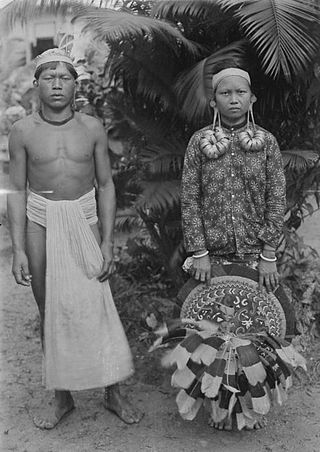
The Apo Kayan people are one of the Dayak people groups that are spread throughout Sarawak of Malaysia, East Kalimantan and North Kalimantan of Indonesia. The earliest Apo Kayan people are from the riverside of the Kayan River, Bulungan Regency, East Kalimantan, Indonesia. According to the Apo Kayan Dayak legend, the Kayan people are the forefathers of which all smaller sub-ethnic Dayak people that are found along the Kayan River came from. Today, the population of the Apo Kayan people are estimated about 64,900.















